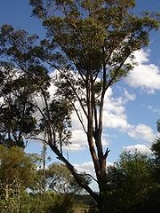
Eucalyptus botryoides
Encyclopedia
Eucalyptus botryoides, Bangalay or Southern Mahogany, is a small to tall tree
. The height may be up to 40 metres. Rough bark covers the trunk and larger branches, is thick, fibrous, and grey-brown to red-brown.
Adult leaves are stalked, broad-lanceolate, to 16 cm long by 40 cm wide, dark green above, pale below. Calyptra
on the bud is partly spherical or conical, the hypanthium
is the same width and longer. The fruit is ovoid or cylindrical in shape, between 7 - 12 mm long, 4 - 6 mm diameter, with the valve near the rim or enclosed.
White flowers appear in summer.
Distribution is coastal south eastern Australia
from near Newcastle
on the mid coast of New South Wales
to eastern Victoria
in the Lakes Entrance area. The species was introduced to Western Australia
, where it is listed as an alien.
The tree was first described by naturalist James Edward Smith
in 1797, without nominating a type specimen.
Tree
A tree is a perennial woody plant. It is most often defined as a woody plant that has many secondary branches supported clear of the ground on a single main stem or trunk with clear apical dominance. A minimum height specification at maturity is cited by some authors, varying from 3 m to...
. The height may be up to 40 metres. Rough bark covers the trunk and larger branches, is thick, fibrous, and grey-brown to red-brown.
Adult leaves are stalked, broad-lanceolate, to 16 cm long by 40 cm wide, dark green above, pale below. Calyptra
Calyptra
Calyptra is a scientific term used in botany. It describes a feature in plant morphology.-Bryophytes:In bryophytes, the calyptra is an enlarged archegonial venter that protects the capsule containing the embryonic sporophyte . The calyptra is usually lost before the spores are released from the...
on the bud is partly spherical or conical, the hypanthium
Hypanthium
A hypanthium is a floral structure consisting of the bases of the sepals, petals, and stamens fused together. Its presence is diagnostic of many families, including the Rosaceae, Grossulariaceae, and Fabaceae...
is the same width and longer. The fruit is ovoid or cylindrical in shape, between 7 - 12 mm long, 4 - 6 mm diameter, with the valve near the rim or enclosed.
White flowers appear in summer.
Distribution is coastal south eastern Australia
Australia
Australia , officially the Commonwealth of Australia, is a country in the Southern Hemisphere comprising the mainland of the Australian continent, the island of Tasmania, and numerous smaller islands in the Indian and Pacific Oceans. It is the world's sixth-largest country by total area...
from near Newcastle
Newcastle, New South Wales
The Newcastle metropolitan area is the second most populated area in the Australian state of New South Wales and includes most of the Newcastle and Lake Macquarie Local Government Areas...
on the mid coast of New South Wales
New South Wales
New South Wales is a state of :Australia, located in the east of the country. It is bordered by Queensland, Victoria and South Australia to the north, south and west respectively. To the east, the state is bordered by the Tasman Sea, which forms part of the Pacific Ocean. New South Wales...
to eastern Victoria
Victoria (Australia)
Victoria is the second most populous state in Australia. Geographically the smallest mainland state, Victoria is bordered by New South Wales, South Australia, and Tasmania on Boundary Islet to the north, west and south respectively....
in the Lakes Entrance area. The species was introduced to Western Australia
Western Australia
Western Australia is a state of Australia, occupying the entire western third of the Australian continent. It is bounded by the Indian Ocean to the north and west, the Great Australian Bight and Indian Ocean to the south, the Northern Territory to the north-east and South Australia to the south-east...
, where it is listed as an alien.
The tree was first described by naturalist James Edward Smith
James Edward Smith
Sir James Edward Smith was an English botanist and founder of the Linnean Society.Smith was born in Norwich in 1759, the son of a wealthy wool merchant. He displayed a precocious interest in the natural world...
in 1797, without nominating a type specimen.

